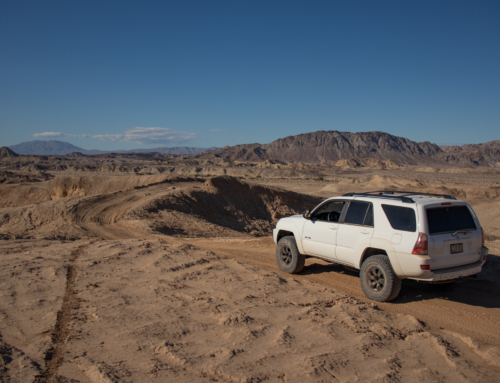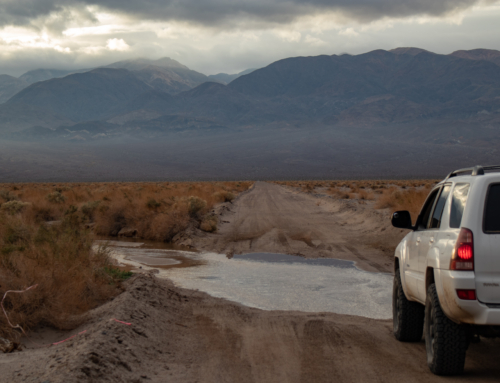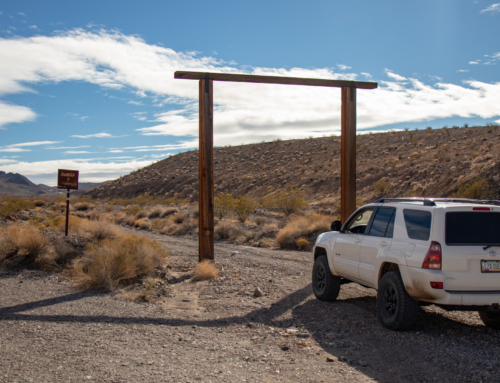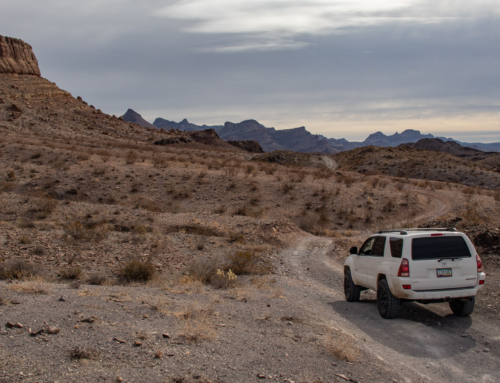After a hectic month, Candace and I were eager to get away for a weekend and mentally reset ourselves. Wanting something local we decided on the high desert – more specifically the Black Mountain and Calico Mountain area.
Just up the 15 freeway to Barstow, we found ourselves in the dirt roughly an hour and half from our driveway. From Irwin Rd, we split off at Fossil Bed Rd that would take us past Rainbow Basin and to the Black Mountain Wilderness area.




During trip planning, I scout camping spots in advance so we don’t waste time looking for one and to ensure that we’re positioned in the best spot possible for viewing our surroundings and point of interests. Managed to find a old established campfire ring just west of the wilderness boundary situated on BLM land and setup ourselves the for the night with music, tasty drinks and a roaring fire.


Morning time Candace made coffee and breakfast while I went exploring around camp. Come to find out, we were surrounded by petroglyphs which gave the area a unique vibe.



Camp spot just left of center. Black Mountain Wilderness is to the right.



A old grave marker?
Ready to move on we packed up and decided to backtrack a bit so we could experience driving through the canyon that runs through Black Canyon during the day.
As always, we always like to clean up and make the area nicer than we found it but that’s the great thing about getting remote and doing the research to find off the beaten path spots. When we arrived it was spotless with no mess to pick up from the previous people that were here. We left it in the same condition other then some temporary tire marks on the dying vegetation.

So here I am talking all high and mighty about treading lightly and yet on the way out we encounter this… To be fair, there was absolutely no sign in the direction we were heading, and when presented with a “Y” in the road we took the one most traveled, which led us here. I began to wonder if maybe I missed something the night before and looked forward to revisiting that trail-head after we looped around.
When I got home, I was able to dig up a BLM ” Environmental Impact Statement” and found the trail we ended up on was listed as being a “Transportation Linear Disturbance” —“Linear disturbances” is used to identify human-made linear features that are not part of the BLM’s transportation system. Linear disturbances may include engineered (planned) as well as unplanned single and two-track linear features that are not part of the BLM’s transportation system.”
In the end we ended up on a closed trail not by choice, but by lack of signage, which blows my mind because during the remainder of our trip, we were amazed at how many BLM signs there were. More then any other area we’ve visited to date.


Worked our way back around the small hills to the west of Black Mountain to start from the beginning.



A very informative board…

This is looking back on the trail we were on the previous night and what ultimately led us to the closure sign on the other side. At least it was a bit of confirmation that we were in fact in the right and not forging our own path or missed a sign along the way. After scoping it out, we continued up and around Black Mountain.




Sign says “Video In Use CAL TIP 888-813-6106
A little further up was the remains of a old stagecoach stop – a old well and trough are all that’s left of a once well used watering hole.
From Maggie Pinder & Donald McGann – Backcountry Adventures Southern California
“The silver boom of 1873 in the Panamint Range led to the development of many roads through the region. Wells Fargo, the major stage company of the time, refused to travel to Panamint City because of its general lawlessness and the risk of holdups. So mine owners there banded together and formed their own company. They shaped their silver into 500-pound half balls that were too heavy to carry off on horseback. The route they took traveled down Black Canyon, where a stage station was set up as an overnight stopping point with wells used for water. Aaron Lane, a trader on the Mojave River, was responsible for pushing the route through Black Canyon.



We attempted to see how deep the well was by using a the piece of lumber that was on-top, but we were unsuccessful at feeling the bottom…
Just a short distance from the stagecoach stop is Scouts Cove, a old dwelling dug out by miners that used to work the area in the early 1900’s. The surrounding mountains contained high-end opal which Tiffany Co. found valuable enough to finance the operation. The workings have since been removed by the BLM.









On the eastern side of the Black Mountain thousands of petroglyphs are scattered throughout Inscription Canyon by the Paleo-Indians that once inhabited the land.


When we arrived to Inscription Canyon, the place was empty with the exception of a single Jeep occupied by a older gentleman and his dog. On the side of his ride was a large “Black Mountain Complex Research Team” sticker and a small table setup with a donation bucket. We said our hello’s and how are ya’s as we walked in to check the place out, and not very long after I noticed he had followed us in.
As we all strolled through the canyon together he began explaining what the petroglyphs meant and at first we were really stoked to have a knowledgeable person there to give us a bit on the history, but then things got a bit off track and turned into his own personal beliefs. Everything from how the different lines on a turtles back referenced to different tribes and circles meaning different years of war, it just seemed like crazy talk after a while and sort of took away from interpreting the drawings ourselves.
Nonetheless, it was an impressive display and was neat to think about Indians once called this place home.




The more you look, the more you see




While it was kind of the gentleman to spend time with us and give us his interpretation and stories of what the petroglyphs mean, they all seemed a bit far-fetched. It was nice to be able to walk out and come up with our own conclusions.


We set off up and over Opal Mountain (seen in the distance) and towards Coolgarde Camp.
From Maggie Pinder & Donald McGann – Backcountry Adventures Southern California
Gold was discovered in easily obtainable deposits in the Mojave Desert around 1900, and a small settlement of several hundred miners soon sprang up. Coolgardie was named after the rich western Australian mining town that became large and famous both for its wealth and its rough nature. California’s Coolgardie never reached the same status, although it was one of the few placer mining districts in the desert. When the gold ran out after just a few short years, there was nothing the desolate place to entice it’s residents to stay.



Looking back towards Inscription Canyon. Slocum Mountains are off in the distance.



“Sign, sign, everywhere a sign. Blockin’ out the scenery, breakin’ my mind. Do this, don’t do that, can’t you read the sign?”
















Thanks Malissa! Everyone sure is glad you know how to deface property and nature… We end up seeing her tagging on various structures and rocks from this point forward.







Before making our way into the Lane Mountain range, we decided to stop for lunch and check out Tonka Town.








Time to move on – the Lane Mountains to the east are the home of some mines and a few abandoned structures. The first of the 3 is the Wells cabin (also referred to as Lane’s / Noble well), built back in 1932.











To the north there are some remains of the American Eagle placer claim and the Starbright Mining operation.



American Eagle housing structure.








Sucks that this is a common theme with shooting spots – in addition to the general trigger trash. At one of our previous camping trips we had a few piece of ammo explode in our camp fire throwing hot coal at us and burning holes into our chairs.
Off to the Starbright Mine through a series of connecting trails through the mountains. This deposit has operated in the past as a small scale production from 1950 to 1951 exacting tungston from the high grade rock. A large open pit, ore bin, structure and offsite storage bunker are all that’s left.











Done exploring the Lane Mountains, we starting making our way east to position ourselves in-between Calico and Coyote Dry Lake.


Left: Coyote Dry Lake. Right: Calico Mountains
Once in the Calico Mountains, we started making our way to a couple camp spots and decide which one would work out best. It had been a long day on a trail and we were both looking forward to a solid dinner and some cold drinks.



The first spot I wanted to check out ended up being a bust. From recent satellite imagery, it was clear the the trail leading into a small canyon was in fact open with a well defined road leading in as well as some sort of man made items placed under a rock ledge. However that wasn’t the case when we arrived to the trail head. While tire tracks were present, large bushes seemed out of place and surrounded by rocks forming a blockade. Decided it wasn’t worth trying to investigate further and moved on.

Further south was a more open area that had some great camping potential but was heavily occupied by a shooting event.


Decided to back track a bit and take a look at a couple spots overlooking Coyote Dry Lake







Ended up settling on a spot I had marked back into a canyon. It seemed as if the area was heavily used with quite a bit of trigger trash and whatnot scattered about. Nonetheless, it made for a great camp and we enjoyed watching the sun disappear behind the mountainside.



Candace began cooking dinner and I fine-tuned the levelness of the Tacoma and got the Tepui setup. From there it was all about relaxing and enjoying the solitude.









We only got about 2 hours of sleep before a large gust of wind woke us up shaking the truck and lifting the hanging base of the tent off the ladder support. Shrugged it off and tried to go back to sleep, but unfortunately the wind was here to stay. Between the truck rocking back and forth and rainfly flapping we didn’t get much sleep and decided to break camp and head straight home at first sign of light and forgo exploring the rest of the Calico Mountains in the morning.
We were greeted by a spectacular sunrise and were home before 10am. Not a bad way to spend a weekend at a local get away!





Until next time!





Very cool trip, lots of great pics! Nice and close to home is a plus too. Thanks for sharing, your trip reports are inspiring to get me back out to the desert, its been too long…
Alex
Thanks for the blog post! Do you have a map of your adventure?
Thanks for the post, we live in Florida. Plan to visit the Black Mountain wildness in March. Is the road ok for a rental Midsize SUV? Thanks for the input.